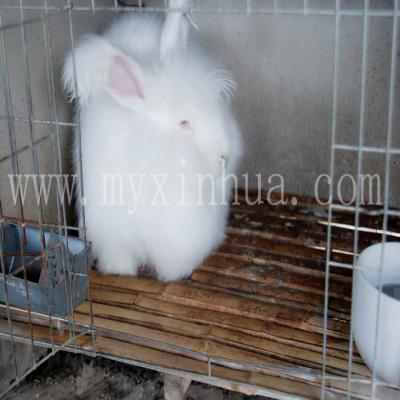①兔舍建筑材料,特别是兔笼材料要坚固耐用,防止被兔啃咬损坏;在建筑上应有防止
长毛兔打洞逃跑的措施。
① The construction materials of rabbit houses, especially the materials of rabbit cages, should be strong and durable to prevent being bitten and damaged by rabbits; Measures should be taken to prevent rabbits from burrowing and escaping on the building.
②兔舍地面要求平整、坚实,能防潮,舍内地面要高于舍外地面20~25厘米,舍内走道两侧要有坡面;室内墙壁、水泥预制板兔笼的内壁、承粪板的承粪面要求平整光滑,易于污垢,易于清洗。
② The floor of the rabbit house shall be flat, solid and moisture-proof. The floor inside the house shall be 20~25cm higher than the floor outside the house. There shall be slopes on both sides of the walkway inside the house; The interior wall, the inner wall of the cement prefabricated slab rabbit cage, and the fece-bearing surface of the fece-bearing plate shall be flat and smooth, easy to remove dirt, and easy to clean and disinfect.
③兔舍窗户的采光面积为地面面积的15%,阳光的入射角度不低于25°~30°。兔舍门要求结实、保温、防兽害,门的大小以方便饲料车和清粪车的出入为宜。
③ The lighting area of the window of the rabbit house is 15% of the ground area, and the incidence angle of sunlight is not less than 25 °~30 °. The door of the rabbit house shall be strong, insulated and protected from animal damage. The size of the door shall be convenient for the access of the feed truck and the manure truck.

④兔舍内要设置排水系统。排粪沟要有一定坡度,以便在打扫和用水冲刷时能将粪尿顺利排出舍外,通往蓄粪池,也便于尿液随时排出舍外,从而降低舍内湿度和有害气体浓度。
④ A drainage system shall be set in the rabbit house. The drainage ditch should have a certain slope, so that when cleaning and washing with water, the feces and urine can be smoothly discharged out of the house, leading to the septic tank, and the urine can be discharged out of the house at any time, so as to reduce the humidity and harmful gas concentration in the house.
⑤为了防疫和,在兔场和兔舍入口处应设置池或盘,并且要方便更换液。
⑤ In order to prevent epidemic and disinfect, disinfection pools or trays should be set at the entrance of rabbit farms and rabbit houses, and it should be convenient to replace the disinfectant.
⑥兔舍内通风。我国南方炎热地区多采用自然通风。自然通风适用于小规模养兔场。机械通风适用于集约化程度较高的大型养兔场。
⑥ Ventilation in the rabbit house. Natural ventilation is often used in hot areas in southern China. Natural ventilation is suitable for small-scale rabbit farms. Mechanical ventilation is suitable for large rabbit farms with high intensity.
此外具有一定规模的兔场要分区布局,一般分成生产区、管理区、生活区、辅助区四大块。
In addition, rabbit farms with a certain scale should be divided into four areas: production area, management area, living area and auxiliary area.
生产区是兔场的核心部分,其方向一般以座南朝北为好,生产区应与生活区并列排列并处偏下风位置。生产区内部应按核心群种兔舍--繁殖兔舍--育成兔舍--幼兔舍的顺序排列,并尽可能避免运料路线与运粪路线的交叉。
The production area is the core part of the rabbit farm. Its direction is generally south to north. The production area should be arranged side by side with the living area and be downwind. The production area shall be arranged in the order of the core group breeding rabbit house - breeding rabbit house - breeding rabbit house - young rabbit house, and the crossing of the material transportation route and the dung transportation route shall be avoided as far as possible.
管理区应靠近大门口,使对外交流更加方便,也减少对生产区的直接干扰。
The management area should be close to the gate to facilitate external communication and reduce direct interference to the production area.
生活区与生产区平行,靠近管理区,但必须在生产区的上风方位。辅助设施建筑区内分两小区,一区包括饲料仓库、饲料加工车间、干草库、水电房等;一区包括兽医诊断室、病兔隔离室、死兔化尸池等。
The living area is parallel to the production area and close to the management area, but it must be upwind of the production area. The building area of auxiliary facilities is divided into two zones. The first zone includes feed warehouse, feed processing workshop, hay warehouse, water and electricity room, etc; The first area includes the veterinary diagnosis room, the isolation room for sick rabbits, and the dead rabbit necropsy pool.
由于饲料加工有粉尘污染,兽医诊断室、病兔隔离室经常接触病原体,因此,辅助区必须设在生产区、管理区和生活区的下风,于各个区域内的具体布局,则本着利于生产和防疫、方便工作及管理的原则,合理安排。更多相关内容就来我们网站
http://www.myxinhua.com咨询!
Due to the dust pollution in feed processing, the veterinary diagnosis room and the isolation room of sick rabbits are often exposed to pathogens. Therefore, the auxiliary area must be located in the downwind of the production area, the management area and the living area. As for the specific layout of each area, it should be reasonably arranged in accordance with the principle of facilitating production and epidemic prevention, convenient work and management. Come to our website for more relevant content http://www.myxinhua.com consulting service


 发布日期:2023-02-20
来源:http://www.myxinhua.com 发布人:admin
发布日期:2023-02-20
来源:http://www.myxinhua.com 发布人:admin